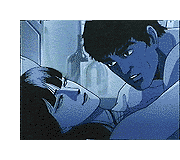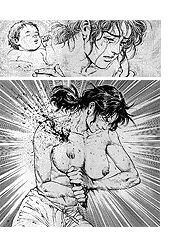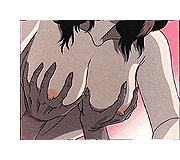|
 |

Imagine if the centaurs in Fantasia abandoned their chaste little picnic and erupted into a wild orgy. The younger, more girlish colts might not be as into it, so they'd get tied up. Then a 1,000-foot high robot in samurai armor locked in battle with an equally huge demon that squirts fire out of tentacles shaped like penises might crash into the scene, killing all the centaurs. 1,000-foot high robot in samurai armor locked in battle with an equally huge demon that squirts fire out of tentacles shaped like penises might crash into the scene, killing all the centaurs.
Or maybe the male centaurs would all die horribly but quickly, while the female centaurs would live long enough to be raped by the penis-tentacles. Eventually a particular virginal centaur, who inherited the mantle of demon slayer from her mother, would finally overcome the duo.
The dénouement described above could very easily play out before the opening credits of a typical Japanese cartoon, or anime -- pronounced ah-nee-may, a corruption of "animation." While Americans are accustomed to most possible iterations of sex and violence, the often insidious power of women to transform in anime is distinctly Japanese. And though the ragged cityscapes and slinky jumpsuits are new, the gender fantasies are an enduring cultural theme that dates back to medieval folklore.
Heavy Metal notwithstanding, Americans have never gotten the hang of cartoons with realistic sex and violence. Meanwhile, since the 1960s Japan's output of anime as television series, movies and made-for-video flicks has been prodigious. They're as much a staple of Japanese pop-culture as the ubiquitous comic books -- called manga -- on which they're often based, estimated to comprise 40 percent of the Japanese publishing industry.
Anime's subject matter is so broad, it's really a medium more than a genre. It encompasses historical drama, like a couple versions of The Diary of Anne Frank and a treatment of the bombing of Hiroshima, as well as comedy, romance and just about anything else you can think of. Most of what makes it to the U.S. is more familiar comic-book fare: action-adventure, science fiction and fantasy. You've probably seen at least half an hour of anime: Speed Racer, perhaps, or Star Blazers. Maybe it was Robotech, or, if you're old enough, AstroBoy. More recently a broader range of anime is creeping out of the college clubs and comic-book conventions into the cultish periphery of the mainstream.
The roles that women play in manga and anime run the gamut. "Asking what the images of women in Japanese manga are like is a little bit like asking what the main ways are of portraying women in U.S. television," says Sharon Kinsella, a professor of Japanese studies at Cambridge University. "What you're really asking about is the state of gender relations in Japan, which is a really fascinating and slightly complicated subject."
A recurring theme in anime, though, is the ability of women to transform. Female protagonists tend to fall along a continuum from maternal (though still sexual) through robotic to outright monstrous. "One of the things that intrigued me about the conception of women in manga is there's usually the stereotypical thing about women being horribly treated, and of course they are," says Susan Napier, a professor of Japanese literature and culture at the University of Texas, Austin. "But often the women are if anything more powerful than the men, infinitely more frightening, infinitely more imaginatively rendered."
Napier's main critical target is a film called Wicked City, directed by Yoshiaki Kawajiri. It's famous primarily for its opening sequence, in which Taki, the James Bond-like hero, picks up a beautiful woman in a bar. They go back to her place and have sex a few times, in a few different positions. After their last climax, as Taki drowses, the woman's hands elongate into pincers; her legs stretch out and bend back impossibly until she enfolds Taki like a spider. He breaks free in the nick of time, and as he flies across the room we see that the woman's vagina has turned into a fang-lined, gnashing maw. (It's hard to know even where to begin with such scenes. As Napier puts it, "Freud would have a field day with this stuff.") beautiful woman in a bar. They go back to her place and have sex a few times, in a few different positions. After their last climax, as Taki drowses, the woman's hands elongate into pincers; her legs stretch out and bend back impossibly until she enfolds Taki like a spider. He breaks free in the nick of time, and as he flies across the room we see that the woman's vagina has turned into a fang-lined, gnashing maw. (It's hard to know even where to begin with such scenes. As Napier puts it, "Freud would have a field day with this stuff.")
As the story progresses we meet Makie, an extraordinarily beautiful woman who is actually a denizen of the Black World, a demon realm, and Taki's opposite number on the police force that regulates both dimensions. Her blood-red nails extend into a two-foot long blade. The bad guy, also from the Black World, has a spectacularly beautiful henchwoman who, unclothed, turns out to be one giant vagina. At one point she pulls Taki inside herself, sending him into paroxysms of ecstasy as a method of extracting information. Taki shoots her.
In the end, after Taki rescues Makie from a brutal demonic gang rape, they admit they've fallen in love. In a glowing, empty church they have sex, which turns out to have been the objective of their bosses all along -- to unify Earth and the Black World. Impregnated by a human male, Makie's powers are magnified enough so she can defeat the villain.
So the transformation that makes Makie the most powerful is the change from sexpot to mom. Motherhood shows up a lot in anime because, as Antonia Levi, author of Samurai from Outer  Space: Understanding Japanese Animation puts it: "The Japanese mother is a force to be reckoned with."Even in Urotsukidoji: Legend of the Overfiend, a series of films famous for their violent misogyny (they're a prime example of the "naughty tentacles," sub-genre), the real power figure is the mother-to-be of the demon messiah. In a manga series called The Legend of Mother Sarah, Katsuhiro Otomo, creator of the crossover near-hit Akira, tells the story of a mother searching post-apocalyptic Earth for her children. In addition to being quite an ass-kicker, Sarah has a bulletproof prosthetic breast; she mutilated herself in anguish and pain when, after her children were taken from her, she continued to lactate. Space: Understanding Japanese Animation puts it: "The Japanese mother is a force to be reckoned with."Even in Urotsukidoji: Legend of the Overfiend, a series of films famous for their violent misogyny (they're a prime example of the "naughty tentacles," sub-genre), the real power figure is the mother-to-be of the demon messiah. In a manga series called The Legend of Mother Sarah, Katsuhiro Otomo, creator of the crossover near-hit Akira, tells the story of a mother searching post-apocalyptic Earth for her children. In addition to being quite an ass-kicker, Sarah has a bulletproof prosthetic breast; she mutilated herself in anguish and pain when, after her children were taken from her, she continued to lactate.
For women in anime, transformation -- whether from slut to mother, human to monster or even human to cyborg -- is a mixed bag. Though the changes usually increase a woman's power, they tend to evoke concerns about not being fully human anymore, and, for monsters and cyborgs, about not being able to have children. It's an ambiguity that dates back over a thousand years to early Japanese folklore.
The first recorded folktale of a woman's transformation* (into a fox) comes from the Fudoki, an eighth-century Buddhist scripture. But more interesting still is a story from the same era in the Kojiki, a primary text from the Japanese folk religion Shintoism, that explains the creation of Japan. Two kami (roughly "gods" or "spirits") named Izanagi and Izanami notice their genitals for the first time -- Izanami says she is insufficiently formed, and Izanagi says he is formed to excess. She suggests that they, you know, get together, and their first child is a leech. Izanagi says the deformation was a result of Izanami having initiated the sexual contact, which was not considered appropriate for women. So he comes on to her, and their children are the islands of Japan and the sun goddess Amaterasu, the foremost among the Shinto kami.
Everything's honeymoon bliss for Izanagi and Izanami until she gives birth to fire, which fatally burns her vagina. Izanagi follows her to the Dark Realm, the unclean Dark Land of the dead, and tells her he wants her back. Izanami agrees, on one condition: that he not look at her. Izanagi disobeys, and sees that she is decomposing. Izanami is so distressed that he's seen her in this state that she promises to kill thousands of his children, to which he responds that he'll just create more. He goes to a river to ritually purify himself, and in the process of purification creates a whole new set of deities who are the ancestors of Japan's aristocracy. "So there are two types of reproduction," says Allan Grapard, a professor of Shinto studies at the University of California, Santa Barbara. "Sexual procreation and production of deities by a male through the act of purification of his body. Purification has always been connected with the production of culture, and mainly a male practice."
Women, however, have also enjoyed some power in Japanese religious history. Temple maidens, in medieval Shinto shrines, called miko, often became possessed by spirits and served as oracles. "The source of speech is located as a presence that only women can communicate with," says Grapard. The miko's power grew out of her sexuality -- some scholars suggest that miko exorcised demons by merging with them, or having sex with them. The mikos preeminence, however, was soon challenged. "Once Buddhism came into Japan and located itself in the countryside, male monks began to be the recipients of oracles." The miko were eventually prohibited from practicing. The grappling for power between monks and miko is well depicted in a medieval painting of a Buddhist monk in a temple corridor entranced by the bare breasts of a miko standing across from him.
In much of anime, it seems this battle is still being waged. Both the women of ancient Shinto and modern anime are imbued with the power to transform, and it is linked to their sex and sexuality. While  neither Buddhism nor Shinto has any proscriptions against sex the way Judeo-Christian traditions do, both Eastern religions do have real problems with the impure and unclean. Menstruation generally qualifies. Men, through ritual purification, create culture and society, all the good stuff about being human. Women, with their frighteningly chaotic, decomposing bodies, are best at overpowering other kinds of chaos, at least since the Buddhists took over the oracle business. Ultimately, the more powerful women become -- monster, cyborg, whatever -- the less human and civilized they are. neither Buddhism nor Shinto has any proscriptions against sex the way Judeo-Christian traditions do, both Eastern religions do have real problems with the impure and unclean. Menstruation generally qualifies. Men, through ritual purification, create culture and society, all the good stuff about being human. Women, with their frighteningly chaotic, decomposing bodies, are best at overpowering other kinds of chaos, at least since the Buddhists took over the oracle business. Ultimately, the more powerful women become -- monster, cyborg, whatever -- the less human and civilized they are.
The most recent fantasy of veiled feminine power may be the current obsession with cuteness, or kawai, which is now prevalent in manga, anime, and Japanese pop culture at large. The fascination with cute is so pervasive that the national uniforms of schoolgirls -- sailor shirt and skirt -- are widely fetishized as erotic objects. The international hit anime series Sailor Moon, for instance, is about a schoolgirl in uniform who goes through puberty and gains superpowers with the wave of her wand. The underpants of young girls have been sold out of vending machines on street corners. The broader phenomena is called lolikon or rorikon, short for "Lolita Complex." But there's disagreement as to whether the fetish is genuinely sexual. "Young women have become the focal point of contemporary Japanese culture, the people who do things, are more lively, insubordinate and interesting," says Cambridge University's Kinsella. "This state of affairs causes a lot of resentment and complications in a society . . . that quite firmly places women in an inferior economic and social position." To some, adolescent girls are the ultimate consumer, free of responsibility but with money to burn, interested only in amusement. That's a harsh contrast with the lot of the men in Japanese society, who work fanatically. "Maybe they're not only desiring her as an object of lust," says Anne Allison, author of Permitted and Prohibited Desires: Mothers, Comics, and Censorship in Japan, "but actually wanting to be a young girl."
Sexual transformation is, indeed, not limited to animation. Kabuki theater, performed only by males, is famous for its onnagata, character actors who perform only female roles, who are considered to be the pinnacle of feminine perfection. The Takarazuka review is a famous all-female performing troup, and the actresses there who perform male parts are often the recipients of crushes from young Japanese girls -- indeed, bishonen, or beautiful males, are androgynous (or outright homosexual) characters popular mostly in girls' manga, but with some crossover appeal. Suffice it to say that the boundaries between genders in Japanese culture are more porous than in the West.
Edo-period Tokyo (during the seventeenth century) was famous for its Yoshiwara pleasure quarter, and equally famous for the Ukiyo-e woodcut prints that represented what went on there in great detail. Why should anime and manga, with their stylistic debt to Ukiyo-e, be any different? "We're reluctant to talk about this," says Napier, "because we don't want to give the impression that the Japanese are any weirder or more sadistic than the rest of the world." Odds are, they're not. The centaurs in Fantasia were pretty weird all on their lonesome.
|

©1997 Adam Rogers and hooksexup.com
|
 |
|